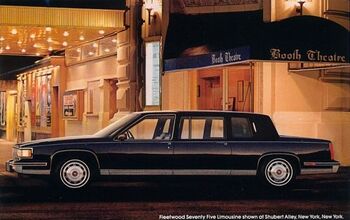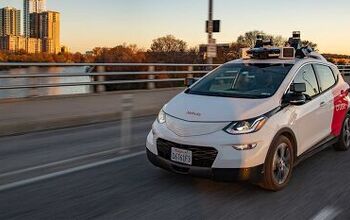Editorial: General Motors Death Watch 254: All That You Dream
The Associated Press called it: GM is set to enter popular parlance as “Government Motors.” When the automaker files for Chapter 11, the nickname will stick, as the debate over GM’s future centers on whether or not the United States government should own a commercial enterprise. To which the only possible answer is no. It was no back when President Bush over-ruled Congress and authorized the first multi-billion dollar “loan.” It’s no now, as the feds prepare to stump-up another $20 billion dollars to keep GM in business. There are lots of reasons why “new” GM is a bad idea. But here’s the most important impediment: Government Motors doesn’t have the vehicles it needs to survive.
Let’s assume “good” GM lowers its cost base to transplant levels and single-out the models that could give the post-C11 automaker a fighting chance. We’ll combine objective information (last month’s sales data) and some subjective analysis (the enthusiast’s perspective).
Although we’ve long argued that Chevrolet and Cadillac are the only GM brands worth saving, that’s not how Government Motors will roll. So we need to identify potential money spinners lingering within Buick, Cadillac, Chevrolet and GMC.
Buick is a lost cause. The “take a look at me now” brand stands for nothing, save God’s waiting room on wheels. In April, the LaCrosse and Lucerne sedans combined generated 1481 sales. That’s more than the Enclave (5,194 vs. 3,731), but less than Toyota Tacoma sales (8,925 vs. 9,027). I’m no fan of the Enclave’s exterior, but we’ve got to keep something. The Enclave stays.
There’s no nice way to put this: Cadillac is another dead brand walking. Last month, the “standard of the world” also accounted or less sales than Ye Olde ToMoCo Taco. Sales of all eight Caddy models combined clocked-in at just 8,337 units. Caddy has some new models in the pipeline, but c’mon. CTS Sportswagon? SRX replacement? While waiting for a flagship, the CTS is the only Cadillac vehicle worth saving, in terms of product excellence and sales (3,876).
GM’s volume brand is looking decidedly lackluster. The Impala topped Chevy’s sales chart in April at 17,532 units. The Malibu and Cobalt are next up, at 14,665 and 10,627 sales respectively. So, despite the fact that the Impala is a low-profit fleet queen and the Cobalt’s a POS, we’ll keep the old girl, the new ‘Bu and the crap ‘Balt. We’ll also hang onto the Camaro. Corvette? If you must. Volt? Cruze? Equinox? More pie-in-the-sky from America’s master BS baker.
Chevy trucks are still where the money is. Incentives be damned; 26,437 Silverado pickup trucks moved off the lots in April. I’m also liking the Traverse (8,204). By [literally] the same token, GMC should keep the badge-engineered Sierra (8,273) and Acadia (4,764), and stay the course with the Tahoe/Suburban twins (12,586 combined).
And there you have it: one Buick, one Cadillac, five Chevy cars, two Chevy trucks and three GMC trucks. Your list may differ here and there, but I reckon these are the eleven vehicles upon which taxpayers will risk at least $40 billion dollars. Which would be OK, if that was the long and short of it. But it isn’t. In fact, it can’t be.
As the New York Times recently asserted (welcome!), we can blame GM’s sclerotic corporate culture for their abject failure to create a complete line of compelling/profitable vehicles. The idea that the United States government will reform GM’s way of being and reverse the curse is completely preposterous. It’s like asking a cocaine dealer to sponsor a crack addict.
Initially, the Chinese walls separating Government Motors’ management from its political masters will prevent excessive tinkering. But there’s no way GM can insulate itself from “undue” political influence. Not when the feds are both the automaker’s controlling stockholder AND its main lender. And certainly not when there are so many GM “stakeholders” ready, willing and able to play political hardball with GM’s new owners.
Why wouldn’t they? The bottom line is that there won’t be a bottom line. The Obama administration may genuinely want to create and then sell off a profitable GM but it’s under no obligation to do so. To wit: there’s no deadline for returning taxpayer’s money. Even if a reasonable turnaround strategy emerges—complete with performance-based reality checks—the new management team is destined to fall afoul of institutional apathy. I mean, we all know how many government-sponsored projects come in on time and/or under budget . . .
Think of it this way: the above list of cars GM needs to keep AND cull to survive presumes that Government Motors’ new overlords will ignore the blowback from closing factories in any given country, state or congressional district. That’s simply not realistic. If the survival of federally-funded weapons programs depend on their sponsors’ political pull as much the systems’ efficacy, why would we expect anything less (or more) from GM’s lineup?
To paraphrase Lowell George, GM’s been down—but not like this before.
More by Robert Farago
Latest Car Reviews
Read moreLatest Product Reviews
Read moreRecent Comments
- Ltcmgm78 It depends on whether or not the union is a help or a hindrance to the manufacturer and workers. A union isn't needed if the manufacturer takes care of its workers.
- Honda1 Unions were needed back in the early days, not needed know. There are plenty of rules and regulations and government agencies that keep companies in line. It's just a money grad and nothing more. Fain is a punk!
- 1995 SC If the necessary number of employees vote to unionize then yes, they should be unionized. That's how it works.
- Sobhuza Trooper That Dave Thomas fella sounds like the kind of twit who is oh-so-quick to tell us how easy and fun the bus is for any and all of your personal transportation needs. The time to get to and from the bus stop is never a concern. The time waiting for the bus is never a concern. The time waiting for a connection (if there is one) is never a concern. The weather is never a concern. Whatever you might be carrying or intend to purchase is never a concern. Nope, Boo Cars! Yeah Buses! Buses rule!Needless to say, these twits don't actual take the damn bus.
- MaintenanceCosts Nobody here seems to acknowledge that there are multiple use cases for cars.Some people spend all their time driving all over the country and need every mile and minute of time savings. ICE cars are better for them right now.Some people only drive locally and fly when they travel. For them, there's probably a range number that works, and they don't really need more. For the uses for which we use our EV, that would be around 150 miles. The other thing about a low range requirement is it can make 120V charging viable. If you don't drive more than an average of about 40 miles/day, you can probably get enough electrons through a wall outlet. We spent over two years charging our Bolt only through 120V, while our house was getting rebuilt, and never had an issue.Those are extremes. There are all sorts of use cases in between, which probably represent the majority of drivers. For some users, what's needed is more range. But I think for most users, what's needed is better charging. Retrofit apartment garages like Tim's with 240V outlets at every spot. Install more L3 chargers in supermarket parking lots and alongside gas stations. Make chargers that work like Tesla Superchargers as ubiquitous as gas stations, and EV charging will not be an issue for most users.































Comments
Join the conversation
Here's a thought: Why won't government motors implement Obama's new CAFE standards immediately? Why wait for 2016? I mean, if changing fuel efficiency is as simple as passing a law, why not have Government Motors lead by example and start immediately producing a full line of vehicles that get 35.5 miles per gallon? Then Americans could shed all those spacious, safe SUVs and Mini-Vans they hate so much and drive match box cars made out of straw and bark that run on Hope and Rainbows and Unicorn poop.